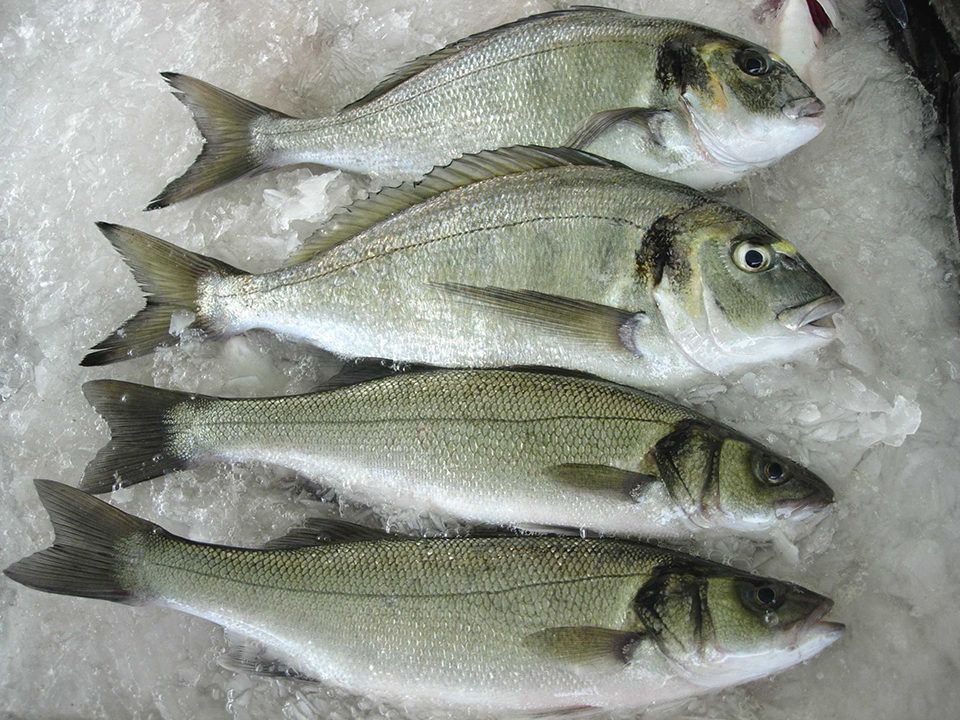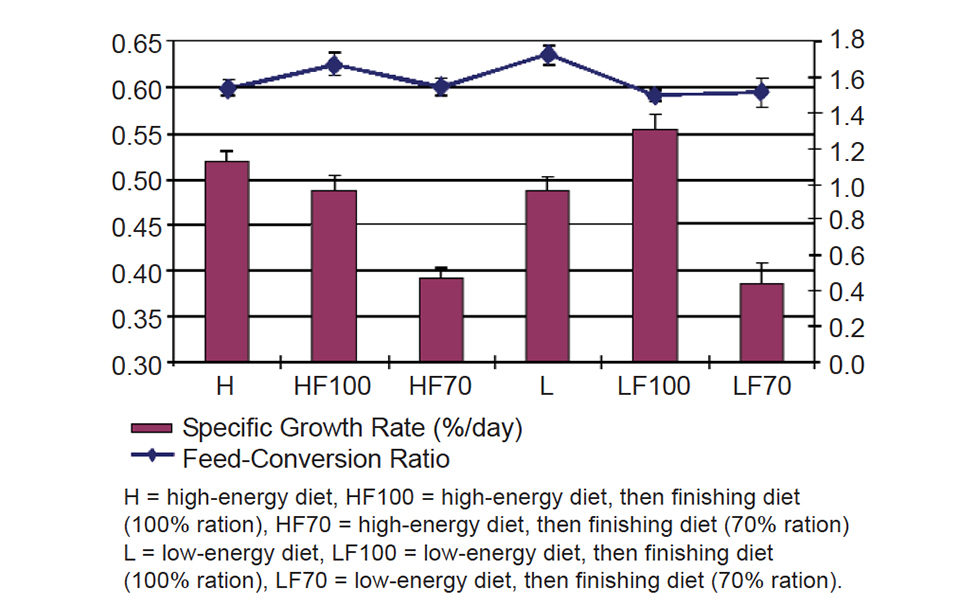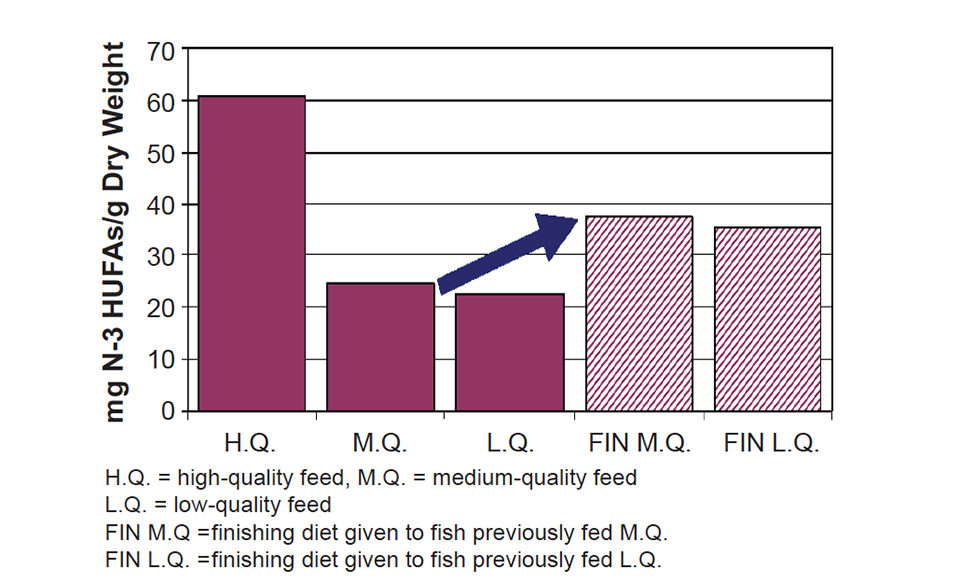Quality improved through feed quality, feed management

The Optimized Aquaculture Product Quality Through Feed Quality and Feed Management (AQUALITY) project was designed to help European marine fish producers improve their competitiveness in the market during a period in which prices for sea bream (Sparus aurata) dropped drastically, affecting the competitiveness of relatively small producers. Funded by the European Commission, the project had two objectives to help small and medium-size enterprises improve their production and marketing strategies:
- Improvement of aquaculture product quality through better feed quality and feeding management. Implemented during the finishing grow-out period for sea bream and sea bass (Dicentrarchus labrax), such management would serve as a model for other commercial culture species.
- Evaluation of a wide range of quality criteria for marine fish to support marketing arguments for high-quality products.
Program research was designed with an upscaling approach, first by testing finishing formulations in the lab under closely controlled conditions and then by field validation in earthen ponds, concrete tanks, and cages, the three most common methods used for grow-out of European sea bass and gilthead sea bream in the Mediterranean region. Five lab trials and six farm trials were carried out.
Laboratory research
Early research showed that the external skin pigmentation of farmed sea bream largely depends on feed quality. Under laboratory conditions, cultured sea bream fed finishing diets produced pigmentation patterns similar to wild sea bream. Concerning specific growth rate and feed conversion, finishing diets produced results that were not significantly different from those of standard commercial grow-out diets.
The improvement of skin pigmentation observed during the trial was confirmed with chromometer measurement and chemical analysis of the carotenoid content of the skin. Animals fed the finishing diet had 4.4 mg total carotenoids per kilograms of skin versus the 1.9 milligrams per kilogram in animals that received a control diet.
In one trial to evaluate the influence of nutritional history and feed ration, it was shown that fish fed a low-energy diet for three months and then switched to a finishing diet had better specific growth and feed conversion than ones fed a high-energy diet continuously (Fig. 1). The same trial demonstrated that a reduction in feed ration yielded lower growth.

Field trials
Results under field trial conditions were more variable, reflecting the influence of more parameters on the external appearance of fish. However, tank and pond trial results showed that the external appearance of cultured sea bass and sea bream was improved with the use of finishing diets.
Tank trials with sea bream of 350-gram initial body weight fed for 60 days with a standard farm diet or finishing diet showed that the resulting specific growth rates and feed-conversion ratios were not significantly different between the treatments. However, considering that the fat content in the finishing diet was 30 percent lower, the effective performance of the finishing diet was better.
To validate these results, a pond trial was carried out using diets formulated to have similar protein and fat specifications. In this test, larger sea bream with body weights of about 569 grams and 599 grams were fed farm feed or a finishing diet, respectively. As shown in Table 1, after four months, the animals that received the finishing diet had a larger weight increase and lower feed conversion (122.06 g and 3.60, respectively) than fish fed the farm diet (76.02 g and 5.68, respectively).
Robles, Mean values for average body weight of large sea bream, Table 1
| Diet | Farm Diet | Finishing Diet |
|---|---|---|
| Survival (%) | 97 | 96 |
| Initial body weight (g) | 568 | 599 |
| Final body weight (g) | 645 | 721 |
| Weight gain (g) | 76 | 122 |
| Specific growth rate (%/day) | 0.11 | 0.16 |
| Feed-conversion rate | 5.68 | 3.60 |
Increased nutritional quality
The lab and field trials showed it was possible to manipulate the nutritional quality of farmed sea bream by providing special finishing feed formulations during the last few months prior to harvest. In particular, the levels of essential nutrients such as omega-3 highly unsaturated fatty acids and specific vitamins like vitamin E could be increased in the final product (Fig. 2).

Other quality parameters evaluated during the project – shelf life, cooking quality, and organoleptic and nutritional qualities – did not show significant differences among treatments. In general, the fish from all trials were considered very fresh, and no differences were found regarding the possible effects of feed formulation on product shelf life under chilled storage. Based on sensory criteria, the shelf life on ice was six or seven days for fish from all trials and up to 11 days with fish from some lab trials.
(Editor’s Note: This article was originally published in the November/December 2006 print edition of the Global Aquaculture Advocate.)
Now that you've finished reading the article ...
… we hope you’ll consider supporting our mission to document the evolution of the global aquaculture industry and share our vast network of contributors’ expansive knowledge every week.
By becoming a Global Seafood Alliance member, you’re ensuring that all of the pre-competitive work we do through member benefits, resources and events can continue. Individual membership costs just $50 a year. GSA individual and corporate members receive complimentary access to a series of GOAL virtual events beginning in April. Join now.
Not a GSA member? Join us.
Authors
-
Rocio Robles
University of Cadiz, Spain
Present Affiliation: Caditec Testing S.L.
Pol E. Trocadero C/Holanda, 29
11510 Puerto Real – Cádiz, Spain[116,101,110,46,97,99,105,110,111,102,101,108,101,116,46,101,46,103,110,105,116,115,101,116,99,101,116,105,100,97,99,64,115,101,108,98,111,114,111,105,99,111,114]
-
Amparo Gonçalves
Fisheries and Sea Research Institute – INIAP/IPIMAR
Department of Technological Innovation and Upgrading of Fish Products – Lisbon, Portugal -
Carlos Cardoso
Fisheries and Sea Research Institute – INIAP/IPIMAR
Department of Technological Innovation and Upgrading of Fish Products – Lisbon, Portugal -
Narcisa Bandarra, Ph.D.
Fisheries and Sea Research Institute – INIAP/IPIMAR
Department of Technological Innovation and Upgrading of Fish Products – Lisbon, Portugal -
M. Leonor Nunes, Ph.D.
Fisheries and Sea Research Institute – INIAP/IPIMAR
Department of Technological Innovation and Upgrading of Fish Products – Lisbon, Portugal -
INVE Aquaculture Nutrition – Dendermonde, Belgium
[46,68,46,104,80,32,44,117,97,101,116,116,117,111,67,32,114,101,116,101,80]
-
Sam Ceulemans
INVE Aquaculture Nutrition – Dendermonde, Belgium
-
Ignacio de la Rosa, Ph.D.
Culmasur – Huelva, Spain
-
Jorge Pedroso
Aqualvor – Odaxeire-Portimao, Portugal
-
Miguel Gonçalves
Aqualvor – Odaxeire-Portimao, Portugal
-
Antonio M. Vieira, Ph.D.
Aqualvor – Odaxeire-Portimao, Portugal
-
John Bitsakos
Bitsakos – Lokridos, Greece
-
Gabriel Mourente, Ph.D.
CASEM University of Cádiz – Department of Biology
Cádiz, Spain
Tagged With
Related Posts

Responsibility
A review of water quality improvement products
Prof. Boyd examines products used by aquafarmers to improve water quality and conditions in their ponds and discusses their efficacy.

Intelligence
‘Quality map’ for coho salmon fillets identifies color, lipid distribution
In research on coho salmon fillets, muscle astaxanthin level, color, and hardness generally increased from the anterior toward the caudal zone of the fish.

Health & Welfare
10 paths to low productivity and profitability with tilapia in sub-Saharan Africa
Tilapia culture in sub-Saharan Africa suffers from low productivity and profitability. A comprehensive management approach is needed to address the root causes.

Intelligence
A brief look at genetically modified salmon
If approved by FDA, fast-growing genetically modified salmon will provide a safe and nutritious product similar to other farmed Atlantic salmon.


